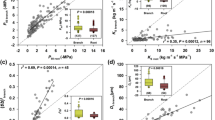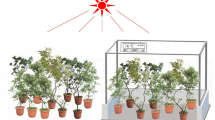Abstract
Key message
Greater transport capacity of diffuse- vs. ring-porous stem networks translated into greater water use by the diffuse-porous co-dominant, but similar growth indicated higher water use efficiency of the ring-porous species.
Abstract
Coexistence of diffuse- vs. ring-porous trees in north-temperate deciduous forests implies a complementary ecology. The contrasting stem anatomies may result in divergent patterns of water use, and consequences for growth rate are unknown. We investigated tree hydraulics and growth rates in two co-dominants: diffuse-porous Acer grandidentatum (“maple”) and ring-porous Quercus gambelii (“oak”). Our goals were (1) document any differences in seasonal water use and its basis in divergent stem anatomy and (2) compare annual growth rates and hence growth-based water use efficiencies. At maximum transpiration, maple trees used more than double the water than oak trees. Maple also had more leaf area per basal area, resulting in similar water use per leaf area between species. Maple had ca. double the tree hydraulic conductance than oak owing to greater conductance of its diffuse-porous stem network (leaf- and root system conductances were less different between species). Water use in maple increased with vapor pressure deficit (VPD), whereas in oak it decreased very slightly indicating a more sensitive stomatal response. Seasonably stable water use and xylem pressure in oak suggested a deeper water source. Although maple used more water, both species exhibited similar annual biomass growth of the above-ground shoot network, indicating greater growth-based water use efficiency of oak shoots. In sum, water use in maple exceeded that in oak and was more influenced by soil and atmospheric water status. The low and stable water use of oak was associated with a greater efficiency in exchanging water for shoot growth.






Similar content being viewed by others
References
Alder NN, Sperry JS, Pockman WT (1996) Root and stem xylem embolism, stomatal conductance, and leaf turgor in Acer grandidentatum populations along a soil moisture gradient. Oecologia 105:293–301
Barbour MG, Billings WD (eds) (1988) North American terrestrial vegetation. Cambridge University Press, New York
Bartelink HH (1997) Allometric relationships for biomass and leaf area of beech (Fagus sylvatica L). Ann Sci For 54:39–50
Bond-Lamberty B, Wang C, Gower ST (2002) Aboveground and belowground biomass and sapwood area allometric equations for six boreal tree species of northern Manitoba. Can J For Res 32:1441–1450
Bovard BD, Curtis PS, Vogel CS, Su HB, Schmid HP (2004) Environmental controls on sapflux in a northern hardwood forest. Tree Physiol 25:31–38
Bush SE, Pataki DE, Hultine KR, West AG, Sperry JS, Ehleringer JR (2008) Wood anatomy constrains stomatal responses to atmospheric vapor pressure deficit in irrigated, urban trees. Oecologia 156:13–20
Bush SE, Hultine KR, Sperry JS, Ehleringer JR (2010) Calibration of thermal dissipation sap flow probes for ring- and diffuse-porous trees. Tree Physiol 30:1545–1554
Calvo-Alvarado JC, McDowell NG, Waring RH (2008) Allometric relationships predicting foliar biomass and leaf area: sapwood area ratio from tree height in five Costa Rican rain forest species. Tree Physiol 28:1601–1608
Christman MA, Sperry JS, Smith DD (2012) Rare pits, large vessels, and extreme vulnerability to cavitation in a ring-porous tree species. New Phytol 193:713–720
Cochard H, Herbette S, Barigah T, Vilagrosa A (2010) Does sample length influence the shape of vulnerability to cavitation curves? A test with the Cavitron spinning technique. Plant, Cell Environ 33:1543–1552
Davis SD, Sperry JS, Hacke UG (1999) The relationship between xylem conduit diameter and cavitation caused by freeze-thaw events. Am J Bot 86:1367–1372
Ehleringer JR, Arnow LA, Arnow T, McNulty IB, Negus NC (1992) Red Butte Canyon Research Natural Area: history, flora, geology, climate, and ecology. Great Basin Natural 52:95–121
Enquist BJ, Niklas KJ (2001) Invariant scaling relations across tree-dominated communities. Nature 410:655–660
Enquist BJ, West GB, Brown JH (2000) Quarter-power allometric scaling in vascular plants: Functional basis and ecological consequences. In: Brown JH, West GB (eds) Scaling in Biology. Oxford University Press, Oxford, pp 167–198
Fownes JH, Harrington RA (1992) Allometry of woody biomass and leaf area in five tropical multipurpose trees. J Trop For Sci 4:317–330
Gasson P (1985) Automatic measurement of vessel lumen area and diameter with particular reference to pedunculate oak and common beech. IAWA Bull 6:219–237
Genet H, Breda N, Dufrene E (2009) Age-related variation in carbon allocation at tree and stand scation during winter and recovery of hydraulic conductivity in diffuse-porous and ring-porous trees. Oecologia 105:435–439
Granier A (1985) Une nouvelle methode pour la mesure du flux de seve brute le tronc des arbres. Ann Sci For 42:193–200
Hacke U, Sauter JJ (1996) Xylem dysfunction during winter and recovery of hydraulic conductivity in diffuse-porous and ring-porous trees. Oecologia 105:435–439
Hacke UG, Sperry JS, Wheeler JK, Castro L (2006) Scaling of angiosperm xylem structure with safety and efficiency. Tree Physiol 26:689–701
Holtta T, Mencuccini M, Nikinmaa E (2011) A carbon cost-gain model explains the observed patterns of xylem safety and efficiency. Plant Cell Environ 34:1819–1834
Jaquish LL, Ewers FW (2001) Seasonal conductivity and embolism in the roots and stems of two clonal ring-porous trees, Sassafras albidum (Lauraceae) and Rhus typhina (Anacardiaceae). Am J Bot 88:206–212
Lens F, Sperry JS, Christman MA, Choat B, Rabaey D, Jansen S (2010) Testing hypotheses that link wood anatomy to cavitation resistance and hydraulic conductivity in the genus Acer. New Phytol 190:709–723
Litvak E, McCarthy HR, Pataki DE (2012) Transpiration sensitivity of urban trees in a semi-arid climate is constrained by xylem vulnerability to cavitation. Tree Physiol 32:373–388
Meinzer FC, Goldstein G, Andrade JL (2001) Regulation of water flux through tropical forest canopy trees: do universal rules apply? Tree Physiol 21:19–26
Meinzer FC, Bond BJ, Warren JM, Woodruff DR (2005) Does water transport scale universally with tree size? Funct Ecol 19:558–565
Meinzer FC, Woodruff DR, Eissenstad DM, Lin HS, Adams TS, McCulloh KA (2013) Above- and belowground controls on water use by trees of different wood types in an eastern US deciduous forest. Tree Physiol 33:345–356
Mencuccini M (2002) Hydraulic constraints in the functional scaling of trees. Tree Physiol 22:553–565
Mencuccini M (2003) The ecological significance of long-distance water transport: short-term regulation, long-term acclimation and the hydraulic costs of stature across plant life forms. Plant Cell Environ 26:163–182
Mencuccini M, Grace J (1996) Developmental patterns of above-ground hydraulic conductance in a Scots pine (Pinus sylvestris L.) age sequence. Plant Cell Environ 19:939–948
Neilson RP, Wullstein LH (1983) Biogeography of two southwest American oaks in relation to atmospheric dynamics. J Biogeogr 10:275–297
Niklas KJ, Spatz HC (2004) Growth and hydraulic (not mechanical) constraints govern the scaling of tree height and mass. Proc Natl Acad Sci USA 101:15661–15663
Pataki DE, Oren R (2003) Species differences in stomatal control of water loss at the canopy scale in a mature bottomland deciduous forest. Adv Water Resour 26:1267–1278
Philips SL, Ehleringer JR (1995) Limited uptake of summer precipitation by bigtooth maple (Acer grandidentatum Nutt.) and Gambel’s oak (Quercus gambelii Nutt.). Trees 9:214–219
Sack L, Tyree MT (2005) Leaf hydraulics and its implications in plant structure and function. In: Holbrook NM, Zwieniecki MA (eds) Vascular Transport in Plants. Elsevier/Academic Press, Oxford, pp 93–114
Sack L, Melcher PJ, Zwieniecki MA, Holbrook NM (2002) The hydraulic conductance of the angiosperm leaf lamina: a comparison of three measurement methods. J Exp Bot 53:2177–2184
Sperry JS, Donnelly JR, Tyree MT (1988) Seasonal occurrence of xylem embolism in sugar maple (Acer saccharum). Am J Bot 75:1212–1218
Sperry JS, Christman MA, Smith DD (2012a) Vulnerability curves by centrifugation: is there an open vessel artifact, and are “r” shaped curves necessarily invalid? Plant Cell Environ 35:601–610
Sperry JS, Smith DD, Savage VM, Enquist BJ, McCulloh KA, Reich PB, Bentley LP, Von Allmen EI (2012b) A species-level model for metabolic scaling in trees I. Exploring boundaries to scaling space within and across species. Funct Ecol 26:1054–1065
Taneda H, Sperry JS (2008) A case-study of water transport in co-occurring ring- versus diffuse-porous trees: contrasts in water-status, conducting capacity, cavitation and vessel refilling. Tree Physiol 28:1641–1652
Tiedemann AR, Clary WP, Barbour RJ (1987) Underground systems of Gambel Oak (Quercus gambelii) in central Utah. Am J Bot 74:1065–1071
von Allmen EI, Sperry JS, Smith DD, Savage VM, Enquist BJ, Reich PB, Bentley LP (2012) A species level model for metabolic scaling of trees II. Testing in a ring- and diffuse-porous species. Funct Ecol 26:1066–1076
Wang J, Ives NE, Lechowicz MJ (1992) The relation of foliar phenology to xylem embolism in trees. Funct Ecol 6:469–475
Warton DI, Wright IJ, Falster DS, Westoby M (2006) Bivariate line-fitting methods for allometry. Biol Rev 81:259–291
Zeppel M (2013) Convergence of tree water use and hydraulic architecture in water-limited regions: a review and synthesis. Ecohydrology. doi:10.1002/eco.1377
Zimmermann MH (1983) Xylem structure and the ascent of sap. Springer, Berlin, Heidelberg, New York
Acknowledgments
We thank Henry Grover and Andy Crowl for field assistance, and Kevin Hultine for technical support of sapflow measurements and calibrations, and Duncan Smith and Mairgereth Christman for technical help in the laboratory. Fred Adler (University of Utah) assisted with data analysis and interpretation. The authors were supported from National Science Foundation grant ATB-0742800; JSS and EIV received additional funding from National Science Foundation grant-IBN-0743148.
Conflict of interest
The authors declare that they have no conflict of interest.
Author information
Authors and Affiliations
Corresponding author
Additional information
Communicated by M. Zwieniecki.
Rights and permissions
About this article
Cite this article
von Allmen, E.I., Sperry, J.S. & Bush, S.E. Contrasting whole-tree water use, hydraulics, and growth in a co-dominant diffuse-porous vs. ring-porous species pair. Trees 29, 717–728 (2015). https://doi.org/10.1007/s00468-014-1149-0
Received:
Revised:
Accepted:
Published:
Issue Date:
DOI: https://doi.org/10.1007/s00468-014-1149-0




